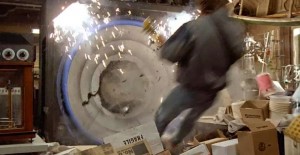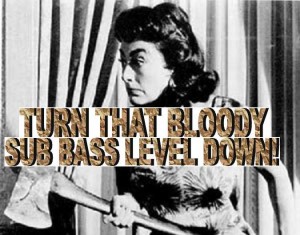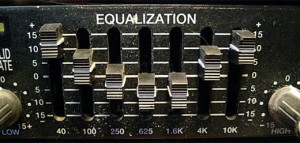by Paul Scarpelli — June 23, 2015
Clipping, impedance, heat, sensitivity, blown drivers, and other annoying mysteries…
The topic of speaker power handling has been addressed several times here at Audioholics, but I wanted to make things a bit easier to understand. There was a superb three-part series done in 2008 by Paul Appolino, and it is far more technical than I will or can ever get. The three pieces are brilliantly composed, and I suggest you read the whole series. This current article will be more from the perspective and real-world experiences of a professional audio guy who for many decades has tried to save people from themselves.
If you own speakers and you have ever…
1) done a smoky burnout in a McDonald’s parking lot;
2) leaped into a backyard pool from a nearby garage roof;
3) stood directly in front of the P.A. stacks at a Weezer concert; or
4) yelled to friends, “Hey, y’all, hold my beer and watch this!”
…you should probably read this article. You’re the guy most likely to blow up your speakers, and it’s totally your fault.
“How many watts will my speakers hold??”
I can’t count the number of times I was asked this question by my overly-enthusiastic customers when I was an audio salesperson. It seemed as if every decibel zealot wanted assurance from me, their Audio Maven, that no matter what music they played at whatever level, their amplifier would never shut down and they would never blow a tweeter. And I could sense their consternation when I couldn’t give them an answer; or, at least, an answer to their liking. The manufacturer of the speaker might rate the speaker at “150 watts” and I had to explain that damage could still be done with a 100-watt receiver, or a 50-watt receiver, or a 350 watt-per-channel separate amplifier. If you set your mind to it, you can and will damage any speaker. If your speakers are rated at 100 watts and your receiver is rated at 100 watts per channel, you’re still not entirely safe.
Most of you know the basics of how a speaker works, but here’s a simple explanation. Conventional dynamic drivers (woofers, midrange, tweeters; cones and domes) have a magnet structure, voice coil, diaphragm, basket, and suspension components. The voice coil consists of a tubular “former” wrapped with thin copper (or less often, aluminum) wire. When an electrical current (the program signal from the amplifier) is applied to the voice coil, a magnetic field is created, making a variable electromagnet. The voice coil moves up and back in the voice coil gap, moving the diaphragm, which is attached by suspension pieces (spider and surround), propagating sound waves. Bass frequencies require more cone area and movement (excursion.) Tweeters require smaller magnets and voice coils and smaller diaphragms to reproduce higher frequencies. A crossover network is employed to direct the appropriate frequencies to the drivers best suited to handle those frequencies, and to filter out frequencies that don’t belong in that driver.
“Turn those suckers up to 11 and rip off the knob!!”
The problems start when we expect an amplifier or speaker to perform beyond its capabilities. To play music louder, more movement is required of the suspended parts of the drivers; the suspension, voice coil, and diaphragm. The harder the speaker is played, the more heat is generated within the voice coil, and, at some point, you will surpass the voice coil’s ability to travel and/or dissipate that heat. Failures of drivers can be from a physical distortion of the voice coil (going out of round from heat) which will result in driver failure, or in some cases even the voice coil wire acting like a fuse and opening from heat. In any event…no tunes, man. Bummer.
Power handling of a loudspeaker system depends upon many things. First, what is the duration of the particular sound? Music is a series of “peaks,” and while you may be listening using an average of 1 to 10 watts, peaks can demand ten or twenty times that much. And a speaker that can handle a 300-watt peak (at a very short duration) at a certain frequency might not be able to handle more than 50 watts for a duration of ten seconds at the same frequency. A note that is at a frequency extreme of the driver’s range may not be handled with as much grace as a note in the center of the driver’s bandwidth. A 12” bass driver may handle a 200 Hz note just fine, but it might struggle with a 25 Hz tone. If you plotted the power handling of a loudspeaker from 20 Hz to 20 kHz, the power handling would vary a great deal by frequency.
If you blow out your speakers, it’s your fault!
Tweeters can handle far less power, and that’s usually okay because there’s far less energy in their useable range. Looking at tweeter specs as I often do (I have no life, apparently), I’ve found that even the manufacturers’ power ratings don’t tell the whole story. A certain $3,250 Seas tweeter will handle 150 watts short term, and 55 watts long term, according to Seas. My own Scan-Speak Revelator tweeters, used in my dedicated theater, used to have an IEC 17.3 max power rating of a very robust (and very suspect) 160 watts RMS. I notice that recently Scan-Speak has omitted that specification, so, as you can see, I am as much in the dark as you are. And a typical tweeter used in a $500-each speaker will employ a driver that has a power rating of maybe 25 watts, and that should be cause for alarm. Just not a very loud alarm.
There are way too many variables to quote reliable power handling numbers, and a generalization won’t do much good in the real world. As a sales and marketing guy who was also on product development teams, I was often faced with how to rate a loudspeaker’s power handling. Some manufacturers of lower-end speakers tend to inflate this spec by blurting out an arbitrary “1,000 watts,” when the speaker would be hard pressed to handle 50 continuous watts. While working for Triad Speakers, I had proposed that rather than to rate our speakers at how much power they would handle before they failed; an exercise in futility; working with the engineers, we decided to forego power handling specs and list recommended amplifier power for each of our 100+ models. Basically, we were inferring “Use an amplifier rated at 50-200 watts per channel into 8 ohms, but don’t do anything stupid.”
There are limits to everything.
Think of powering a speaker the way you might think about riding a bicycle. Greg LeMond, three-time Tour de France winner between 1986 and 1990, has stated that a professional cyclist can only sustain a flat-out effort for 45 seconds, possibly generating up to 1,500 watts. Typically, this would occur in a sprint. A stage of the Tour de France might take more than six hours, with an average output of between 200-300 watts. As with a loudspeaker and amplifier, output can go higher as the duration of the effort gets shorter. With a cyclist, the anaerobic threshold is where demand for oxygen exceeds what the athlete can take in and process, and lactic acid accumulates in the muscles faster than it can be dissipated. In the case of a speaker, the voice coil excursion exceeds its limits (x-max) and/or heat in the voice coil cannot dissipate fast enough. (X-max generally refers to the maximum distance a voice coil can move linearly in one direction from rest, expressed in millimeters.)
Compression also occurs as a driver is over-driven. As the voice coil becomes hotter, its resistance increases and the driver’s sensitivity is reduced, exacerbating the problem. The harder you drive a speaker that’s already compressing, the less responsive it becomes. Compression at lower levels simply dulls the peaks in the music and may be inaudible, but severe compression makes the music harsh, not dynamic, and high in distortion.
“If it’s too loud, you’re too old!”
You may have heard that too little power will blow a tweeter faster than too much power, and that’s not exactly true. Usually when a loudspeaker is damaged, it’s from too much power for too long a duration, or playing it excessively loud for even a short period. What is true about the “too little power” statement is that when a receiver or amplifier is driven into hard clipping, the resulting distortion has more nasty high frequency content making it easier to damage a tweeter. The term “clipping” comes from the visualization of what the signal looks like on an oscilloscope. The top of the waveform looks flattened, compressed, or “clipped off.” I’ve heard the term used with speakers when they are overdriven to the point where they start to compress transients, either in the drivers or by crossover saturation, but I prefer to use clipping only as an amplifier term. And while I recommend more amplifier power with low-impedance capability, over-driving a speaker is still the fastest way to damage it. Factoring in yet another variable, some amplifiers clip gracefully, either by inherent design or additional circuitry. This is called “soft clipping.” Other amplifier output stages don’t behave as well at clipping, and they produce a cornucopia of odd-order harmonics that can cause tweeter voice coils to overheat.
Most of today’s receivers have their output power rated at 8 ohms, and they have difficulty at lower impedances, due to intentional current-limiting. The problem is few speakers are a benign 8 ohm load. Most 8-ohm speakers dip to 4-6 ohms at some frequencies and at system resonance, they can measure as high as 20 ohms or more. Not only don’t you know how much power your speaker can handle, you don’t know how much power your receiver can deliver at that frequency! A good solid state amplifier will deliver varying power depending on the frequency and magnitude of the impedance the speaker presents it. But, the amplifier output should remain a constant voltage source until it current limits at low impedance and high output levels. (Tube amplifiers don’t react the same way, but that’s a different discussion.)
“Crank up the drums, crank up the bass, crank up my Les Paul in your face!”
Okay, it gets worse, and I’ve mentioned this in other articles. Do you use equalization in your system? Keep in mind that when you increase a frequency by 3 dB (mildly perceptible increase), you double the power you use at that frequency, and you’re more likely to drive your amplifier or speaker into distortion. And equalization tends to be applied at the frequency extremes; right where it can do the most damage. For example, if you boost 12 dB at 10 kHz on your EQ, you are now using sixteen times the power at 10 kHz. If peaks were 25 watts before adding equalization, with a 12 dB boost, peaks are now demanding 400 watts. That dog don’t hunt. And simple bass and treble controls on receivers can allow you to boost as much as 18 dB, which is also a recipe for disaster. Tone controls should not be used the way you use ketchup at 2:00 AM on a Sunday morning.
So, how do you avoid damaging your speakers? It comes down to common sense. Don’t boost EQ much at all. Use an equalizer to cutpeaks. Don’t listen at abusively high levels. Sit closer to your speakers, if you can. Every time you “half” the distance from your speakers, you gain approximately 6 dB of headroom. If you have a receiver, use a separate amplifier of higher power and better low-impedance capability. If output is the most important thing to you, consider very efficient speakers. If you play your speakers outside, you won’t have much output or bass, and turning up the bass will only hasten the demise of your speakers. You can’t play bass-heavy music as loudly. You can’t play music that’s mastered hotter as loudly. If you’re listening at a high level and you turn it up higher and the sound doesn’t get louder; you’ve exceeded your system’s limits. Either the amp or speakers, or both, are compressing and distorting. And know that if you blow a center channel tweeter, it was because the center channel got the brunt of the power during a movie. If you notice any kind of compression or distortion at all, turn it down a notch or two. One safeguard is to calibrate your system to THX standards, and then don’t exceed the reference level…by much.
Conclusion
Some speakers have higher sensitivity and more robust drivers, but in the end, any speaker can be damaged if you apply yourself to the task. I could tell you I have never blown a speaker, but I would be lying to you. If you’ve chosen the appropriate speakers for how you listen, and the proper amplification for driving them (and you’re not a maniac), you should be okay. Have fun, but be careful, kids, and always remember that when you blow your speakers…it’s totally your fault.
http://www.audioholics.com/loudspeaker-design/truth-about-matching-amplifier-power





